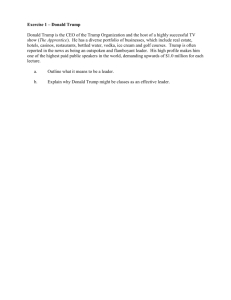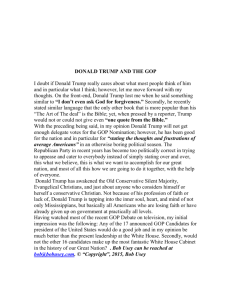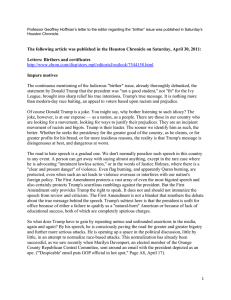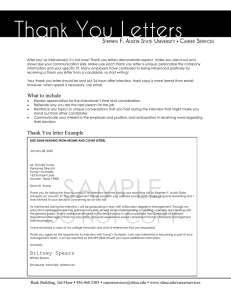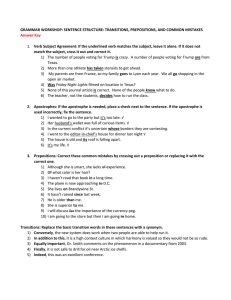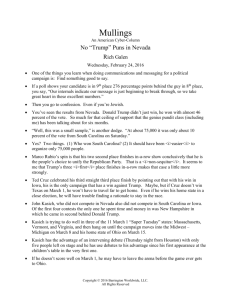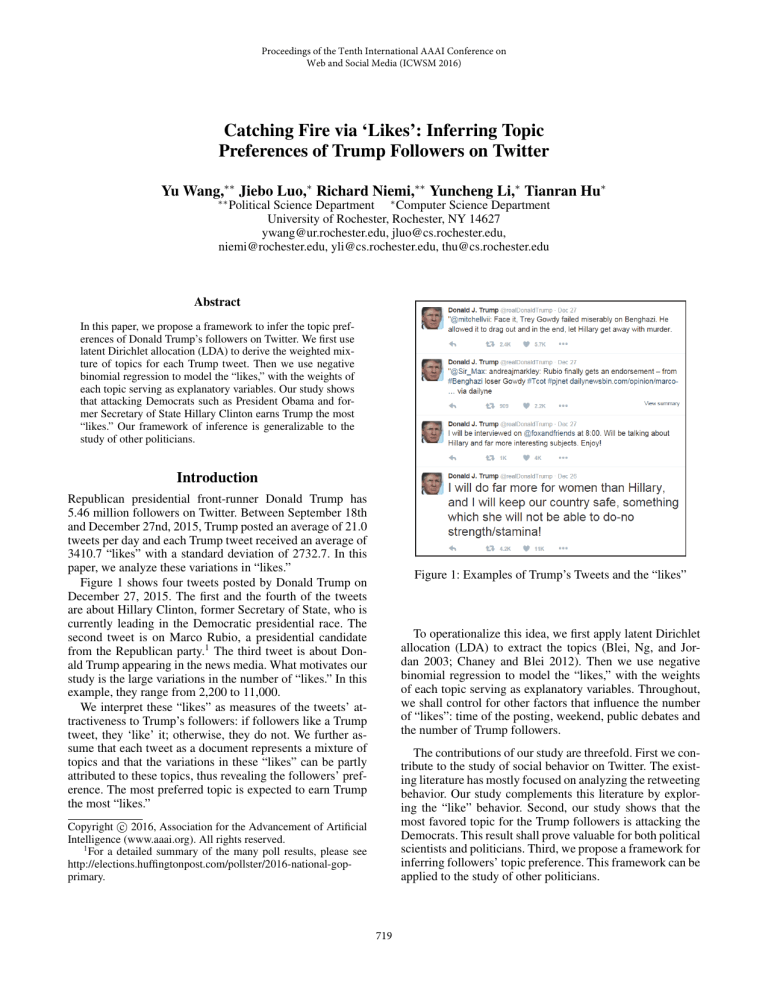
Proceedings of the Tenth International AAAI Conference on
Web and Social Media (ICWSM 2016)
Catching Fire via ‘Likes’: Inferring Topic
Preferences of Trump Followers on Twitter
Yu Wang,∗∗ Jiebo Luo,∗ Richard Niemi,∗∗ Yuncheng Li,∗ Tianran Hu∗
∗∗
Political Science Department ∗ Computer Science Department
University of Rochester, Rochester, NY 14627
ywang@ur.rochester.edu, jluo@cs.rochester.edu,
niemi@rochester.edu, yli@cs.rochester.edu, thu@cs.rochester.edu
Abstract
In this paper, we propose a framework to infer the topic preferences of Donald Trump’s followers on Twitter. We first use
latent Dirichlet allocation (LDA) to derive the weighted mixture of topics for each Trump tweet. Then we use negative
binomial regression to model the “likes,” with the weights of
each topic serving as explanatory variables. Our study shows
that attacking Democrats such as President Obama and former Secretary of State Hillary Clinton earns Trump the most
“likes.” Our framework of inference is generalizable to the
study of other politicians.
Introduction
Republican presidential front-runner Donald Trump has
5.46 million followers on Twitter. Between September 18th
and December 27nd, 2015, Trump posted an average of 21.0
tweets per day and each Trump tweet received an average of
3410.7 “likes” with a standard deviation of 2732.7. In this
paper, we analyze these variations in “likes.”
Figure 1 shows four tweets posted by Donald Trump on
December 27, 2015. The first and the fourth of the tweets
are about Hillary Clinton, former Secretary of State, who is
currently leading in the Democratic presidential race. The
second tweet is on Marco Rubio, a presidential candidate
from the Republican party.1 The third tweet is about Donald Trump appearing in the news media. What motivates our
study is the large variations in the number of “likes.” In this
example, they range from 2,200 to 11,000.
We interpret these “likes” as measures of the tweets’ attractiveness to Trump’s followers: if followers like a Trump
tweet, they ‘like’ it; otherwise, they do not. We further assume that each tweet as a document represents a mixture of
topics and that the variations in these “likes” can be partly
attributed to these topics, thus revealing the followers’ preference. The most preferred topic is expected to earn Trump
the most “likes.”
Figure 1: Examples of Trump’s Tweets and the “likes”
To operationalize this idea, we first apply latent Dirichlet
allocation (LDA) to extract the topics (Blei, Ng, and Jordan 2003; Chaney and Blei 2012). Then we use negative
binomial regression to model the “likes,” with the weights
of each topic serving as explanatory variables. Throughout,
we shall control for other factors that influence the number
of “likes”: time of the posting, weekend, public debates and
the number of Trump followers.
The contributions of our study are threefold. First we contribute to the study of social behavior on Twitter. The existing literature has mostly focused on analyzing the retweeting
behavior. Our study complements this literature by exploring the “like” behavior. Second, our study shows that the
most favored topic for the Trump followers is attacking the
Democrats. This result shall prove valuable for both political
scientists and politicians. Third, we propose a framework for
inferring followers’ topic preference. This framework can be
applied to the study of other politicians.
c 2016, Association for the Advancement of Artificial
Copyright Intelligence (www.aaai.org). All rights reserved.
1
For a detailed summary of the many poll results, please see
http://elections.huffingtonpost.com/pollster/2016-national-gopprimary.
719
Related Work
Our work builds upon previous research on electoral studies
using social media data and on behavioral studies in social
media.
There are a large number of studies on using social media data to analyze and forecast election results. (DiGrazia
et al. 2013) finds a statistically significant relationship between tweets and electoral outcomes. (MacWilliams 2015)
suggests that a candidate’s number of “likes” in Facebook
can be used for measuring a campaign’s success in engaging the public. According to (Williams and Gulati 2008), the
number of Facebook fans constitutes an indicator of candidate viability. (Wang, Li, and Luo 2016) uses the profile images on Twitter to study the demographic characteristics of
Donald Trump’s and Hillary Clinton’s followers. Our work
uses both the number of Trump followers (as a control variable) and the number of “likes” (as the dependent variable).
Our contribution is to infer follower preferences from these
“likes.”
There are also quite a few studies modeling individual behaviors in social media. (Lee et al. 2015) models the decision
to retweet, using Twitter user features such as agreeableness,
number of tweets posted, and daily tweeting patterns. (Mahmud, Chen, and Nichols 2013) models individuals’ waiting
time before replying to a tweet based on their previous replying patterns. Our study models the number of “likes” that
a Trump’s tweet receives. Our innovation is to use tweetspecific features instead of individual-specific features, as
done in the above-cited literature.
Figure 3: (Time series) ‘Likes’ per Trump Tweet
Table 1: Summary statistics
Variable
Min Max Mean S.D. N
Likes
741 30612 3411 2733 2120
Democratic Debates 0
1
0.088 0.283 2120
Republican Debates 0
1
0.072 0.258 2120
Followers (million) 4.50 5.45 4.788 0.344 2064
LDA and negative binomial regression are the two
workhorses of our work. We first use LDA to extract topics
from the tweets and then use negative binomial to estimate
the coefficients for each topic. In our estimation, we use the
following two link functions:
μ = exp(β0 + β1 Weekend + β2 Democratic Debates
+ β3 Republican Debates + β4 Follower Count
+ γ · Topic + θ · Hour Controls)
p = 1/(1 + αμ)
Data and Methodology
We use the dataset US2016, constructed by us with Twitter
data. The dataset contains a tracking record of the number of
followers for all the major candidates in the 2016 presidential race, including Donald Trump (Figure 2). The dataset
spans the entire period between September 18th, 2015 and
December 27th, 2015 and covers three Democratic debates
and three Republican debates. In addition, US2016 also contains all the tweets (2120, in total) that Trump posted during
the same period and the number of “likes” that each tweet
has received (Figure 3). In Table 1, we report the summary
statistics of the main variables.
where Democratic Debates is binary and takes the value
of 1 on the day of a Democratic debate and on the day immediately after the debate, Republican Debates is binary and
takes the value of 1 on the day of a Republican debate and
on the following day. Weekend is binary and is 1 if the tweet
is posted during the weekend. Follower Count is the number of Trump followers when the tweet is posted. Topic is
a vector and denotes the weights on each topic. Hour Controls are a set of dummy variables controlling for the hours
when the tweet is posted. α controls the gamma distribution,
Gamma(1/α, α), that generates over-dispersion.
With these two equations, we formulate the likelihood as
follows and use it to estimate the coefficients:
Γ(1/α + y)
p1/α (1 − p)y
Γ(y + 1)Γ(1/α)
where y denotes the number of “likes.”
To select the appropriate number of topics for the LDA
procedure, we use as a metric the resulting mean absolute
error (MAE) of the negative binomial regression.
In Figure 4, we report the MAE as a function of the number of topics, from 2 to 9. We observe that MAE first decreases when the number of topics increases from 2 to 4
and then remains relatively flat. MAE achieves its minimum
Figure 2: (Time series) Number of Trump Followers
720
when the number of topics equals 4, so we shall set the number of topics to 4 in the subsequent analysis.2
Column 1 does not include the extracted topics as explanatory variables and serves as the baseline. It shows that
tweets Trump posted during Democratic debates tend to receive more “likes” and tweets posted during Republican debates tend to receive fewer “likes.” A similar observation is
reported in (Wang, Li, and Luo 2016). The coefficient on
Follower Count is positive and statistically significant, suggesting that the more followers Trump has the more “likes”
a Trump tweet will receive. We also find that tweets posted
during the weekend tend to receive fewer “likes.”
By contrast, Column 2 includes the topic variables. First,
by the Akaike Information Criterion (AIC), we shall select the Column 2 specifications. Second, we exclude the
topic News Media from the regression to avoid perfect multicollinearity as the four topics sum up to 1. We find that
the topics Democrats and Trump Campaign are statistically
more preferred to News Media. The difference between Republicans and News Media is not statistically significant.
Figure 4: Mean Absolute Error as a Function of Topics
Table 2: Negative Binomial Regression
Main Results
In this section, we first present the four topics that we uncover from the LDA procedure. We then report our main estimation results. Lastly, we discuss the estimated differences
between these topics.
likes
Democratic Debates
Republican Debates
Topic Classification
Follower Count
In Table 3, we report the four topics that we obtain after
applying the LDA procedure to the Trump tweets, together
with the top 20 topic words.
We observe these tweets can be classified into four topics: News Media, Republicans, Democrats, and Trump Campaign. News Media contains such topic words as foxnews,
cnn, interview and abc. Republicans includes names of Republican candidates such as Jeb Bush, Marco Rubio, Ben
Carson and Ted Cruz. Democrats includes names from the
Democratic party, such as Hillary Clinton and President
Obama. Trump Campaign relates to Trump’s performance
in polls and speeches. It includes such words as polls and
crowd.
Based on this classification, the first, third, and fourth
tweets in Figure 1 shall assign large weights to Democrats as
they all relate to Hillary Clinton. The second tweet assigns a
large weight to the topic Republicans as it relates to Marco
Rubio, a presidential candidate from the Republican party.
And the third tweet assigns a large weight also to the News
Media topic, as it is about Donald Trump appearing in the
news.
Weekend
Baseline
Topics
0.365∗∗∗
(0.0423)
-0.225∗∗∗
(0.0479)
0.691∗∗∗
(0.0335)
-0.135∗∗∗
(0.0269)
4.688∗∗∗
(0.217)
0.286∗∗∗
(0.0412)
-0.165∗∗∗
(0.0463)
0.629∗∗∗
(0.0326)
-0.113∗∗∗
(0.0260)
0.0368
(0.0447)
0.545∗∗∗
(0.0456)
0.0840∗
(0.0421)
4.878∗∗∗
(0.212)
-1.270∗∗∗
(0.0298)
2063
36312.5
-1.346∗∗∗
(0.0299)
2063
36148.2
Republicans
Democrats
Trump Campaign
Constant
ln(α)
Constant
Observations
AIC
Standard errors in parentheses
∗
p < 0.05, ∗∗ p < 0.01, ∗∗∗ p < 0.001
Using likelihood ratio test on α, we are further able to
confirm the existence of over-dispersion, and thus confirm
that negative binomial regression is more appropriate than
Poisson regression.
Estimation
In this subsection, we use the weights derived from the LDA
procedure to estimate the topic preferences of the Trump followers on Twitter. We follow the formulation presented in
Section 3 and we report the estimation results in Table 2.
The Most Preferred Trump Topic
To visualize the results, we plot the estimated coefficients
with 95% confidence intervals in Figure 3. News Media, taking the value of 0, serves as the baseline for comparison. The
confidence intervals for Democrats and Trump Campaign
2
Selecting a much larger number of topics, for example 17,
yields an even smaller MAE. But such a larger number of topics
will make interpretation very difficult.
721
Table 3: Topic Classification
Topics
Top 20 Topic Words
trump great america thank again donald make foxnews makeamericagreatagain nice thanks cnn interview
News Media
president good more tonight job vote need
trump cnn poll rubio carson won jeb debate bush jebbush campaign gop marco immigration people
Republicans
foxnews still candidate megynkelly money
hillary president why people obama like many going get isis right clinton country want need doing them
Democrats
against foxnews last
trump great new poll thank makeamericagreatagain live donald crowd america iowa big night morning
Trump Campaign
book cnn tonight people tomorrow polls
are both above 0, suggesting that Trump followers prefer
Democrats and Campaign to News Media. By comparison,
the confidence interval for Republicans is not strictly positive.
More important, we observe that Democrats is the most
preferred topic among Trump followers, which is consistent
with our earlier observation that tweets posted during Democratic debates tend to receive more “likes.” Referring back to
the quoted tweets in Figure 1, this helps explain why tweets
mentioning Hillary Clinton receive more “likes.”
the framework of inference that we propose here can be applied to the study of other politicians, such as Hillary Clinton
and President Barack Obama.
We believe the rise of Donald Trump is a significant event
in American politics. Our immediate next step is to understand the demographics of the Trump followers on Twitter
and evaluate their sentiments through, e.g., tweets.
Acknowledgment
We gratefully acknowledge support from the University of
Rochester, New York State through the Goergen Institute for
Data Science, and our corporate sponsors Xerox and Yahoo.
References
Blei, D. M.; Ng, A. Y.; and Jordan, M. I. 2003. Latent
dirichlet allocation. Journal of Machine Learning Research
3:993–1022.
Chaney, A. J., and Blei, D. M. 2012. Visualizing topic models. In Proceedings of the Sixth International AAAI Conference on Weblogs and Social Media.
DiGrazia, J.; McKelvey, K.; Bollen, J.; and Rojas, F. 2013.
More tweets, more votes: Social media as a quantitative indicator of political behavior. PlOS ONE 8:1–5.
Lee, K.; Mahmud, J.; Chen, J.; and Zhou, M. 2015. Who
will retweet this? detecting strangers from twitter to retweet
information. ACM Transactions on Intelligent Systems and
Technology 4:1–25.
MacWilliams, M. C. 2015. Forecasting Congressional Elections Using Facebook Data. PS: Political Science & Politics
48(04).
Mahmud, J.; Chen, J.; and Nichols, J. 2013. When will
you answer this? estimating response time in twitter. In Proceedings of the Seventh International AAAI Conference on
Weblogs and Social Media, 697–700.
Wang, Y.; Li, Y.; and Luo, J. 2016. Deciphering the 2016
U.S. Presidential Campaign in the Twitter Sphere: A Comparison of the Trumpists and Clintonists. In Tenth International AAAI Conference on Web and Social Media.
Williams, C. B., and Gulati, G. J. 2008. The Political Impact of Facebook: Evidence from the 2006 Midterm Elections and 2008 Nomination Contest. Politics & Technology
Review, March, 11-21. Politics & Technology Review 11–
21.
Figure 5: Estimated Topic Coefficients (95% C.I.)
Conclusion and Future Work
We have presented a study of the topic preferences of the
presidential candidate Donald Trump’s followers on Twitter. We first used latent Dirichlet allocation (LDA) to extract
topics from Trump’s tweets and then regressed the number
of “likes” on the weighted mixture of topics. We used Mean
Absolute Error (MAE) from the negative binomial regression as a metric to select the appropriate number of topics.
We found that Democrats is the most preferred topic among
Trump followers. While our work focuses on Donald Trump,
722

